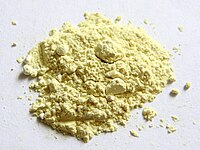
Photo from wikipedia
Abstract The solid solution constructed by two or more semiconductors with different bandgaps can effectively modulate the energy band, satisfying the redox potential for both H+/H2 and O2/H2O. In this… Click to show full abstract
Abstract The solid solution constructed by two or more semiconductors with different bandgaps can effectively modulate the energy band, satisfying the redox potential for both H+/H2 and O2/H2O. In this paper, Sillen-Aurivillius compounds with layered structure Bi3O4Cl and Y3O4Cl solid solution (Bi3−xYxO4Cl) were successfully synthesized by the solid-phase method. The absorption edge of Bi3−xYxO4Cl could be dramatically changed from about 500–740 nm with the increase of Bi elements, which accounted for the entire UV-Vis region of the solar spectrum. Furthermore, the bandgaps for Bi3−xYxO4Cl could be adjusted from about 2.6–2.0 eV with the decreased Y/Bi ratio from 2 to 0.2. Significantly, the conduction band minimum energy (CBM) of Bi3−xYxO4Cl all satisfied the redox potential for H+/H2, which showed excellent visible-light photocatalytic water splitting.
Journal Title: Journal of Alloys and Compounds
Year Published: 2021
Link to full text (if available)
Share on Social Media: Sign Up to like & get
recommendations!